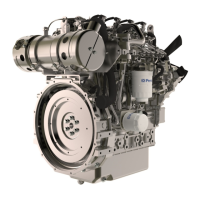i03632416
Aftercooler Core - Inspect
Note: Adjust the frequency of cleaning according to
the effects of the operating environment.
Inspect the aftercooler for these items: damaged fins,
corrosion, dirt, grease, insects, leaves, oil and other
debris. Clean the aftercooler, if necessary.
For air-to-air aftercoolers, use the same methods that
are used for cleaning radiators.
Personal injury can result from air pressure.
Personal injury can result without following prop-
er procedure. When using pressure air, wear a
protective face shield and protective clothing.
Maximum air pressure at the nozzle must be less
than 205 kPa (30 psi) for cleaning purposes.
After cleaning, start the engine and accelerate the
engine to high idle rpm. This will help in the removal
of debris and drying of the core. Stop the engine. Use
a light bulb behind the core in order to inspect the
core for cleanliness. Repeat the cleaning, if
necessary.
Inspect the fins for damage. Bent fins may be opened
with a “comb”.
Note: If parts of the aftercooler system are repaired
or replaced, a leak test is highly recommended.
Inspect these items for good condition: Welds,
mounting brackets, air lines, connections, clamps
and seals. Make repairs, if necessary.
i02322311
Alternator - Inspect
Perkins recommends a scheduled inspection of the
alternator. Inspect the alternator for loose
connections and correct battery charging. Check the
ammeter (if equipped) during engine operation in
order to ensure correct battery performance and/or
correct performance of the electrical system. Make
repairs, as required.
Check the alternator and the battery charger for
correct operation. If the batteries are correctly
charged, the ammeter reading should be very near
zero. All batteries should be kept charged. The
batteries should be kept warm because temperature
affects the cranking power. If the battery is too cold,
the battery will not crank the engine. When the
engine is not run for long periods of time or if the
engine is run for short periods, the batteries may not
fully charge. A battery with a low charge will freeze
more easily than a battery with a full charge.
i06675903
Alternator and Fan Belts -
Replace
Illustration 40 g06069465
Typical example
(1) Mounting bolt
(2) Adjusting bolt
(3) Mounting bolt
Note: When a new belt is installed, check the belt
tension again after 20 hours of engine operation.
Refer to the Disassembly and Assembly Manual for
the installation procedure and the removal procedure
for the belt.
Belt tension for a new belt is between 400 N to 489 N
(90 lb to 110 lb).
For applications that require multiple drive belts,
replace the belts in matched sets. Replacing only one
belt of a matched set will cause the new belt to carry
more load because the older belt is stretched. The
additional load on the new belt could cause the new
belt to break.
76
SEBU9075-03
Maintenance Section
Aftercooler Core - Inspect

